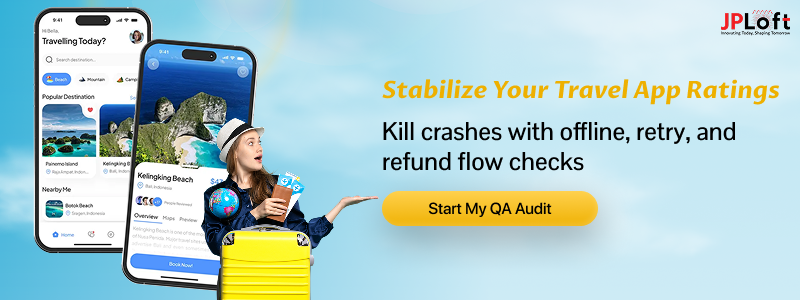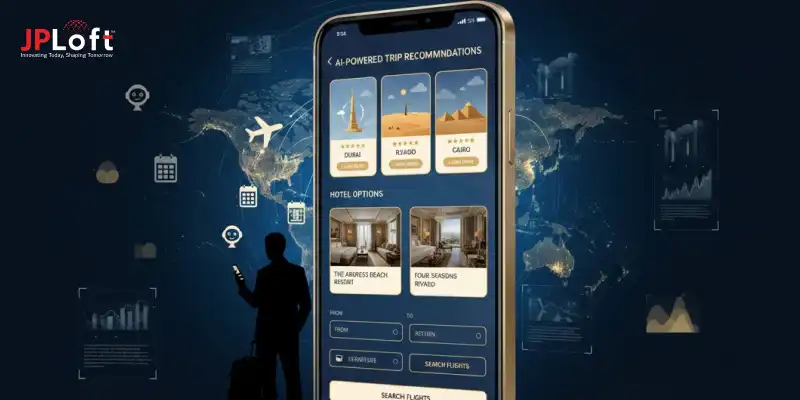Key Takeaways:
A well-structured Guide to Travel App Testing is essential to ensure your travel app delivers seamless functionality, security, and reliability across devices and platforms.
Following a clear process of travel app testing that includes functional, usability, and performance checks helps reduce risks and guarantees a smooth launch.
AI, ML, and automation tools are transforming travel app testing by making it faster, more accurate, and cost-effective, helping businesses stay competitive in 2025.
The overall testing cost depends on app features, integrations, complexity, and the choice of tools or testing partners, making budgeting a critical step.
Partnering with JPLoft ensures expert guidance, robust testing, and a future-ready app that stands out in a crowded market.
Travel apps have become the go-to solution for today’s digital travelers, offering everything from booking flights and hotels to planning itineraries in one click.
But with users demanding smooth experiences and zero downtime, ensuring quality is no longer optional. That’s where a well-structured guide to travel app testing becomes essential.
From performance and security checks to user experience optimization, testing guarantees that every feature works flawlessly before reaching the market.
This travel app testing guide will walk you through the importance of testing, proven tools, step-by-step processes, and the role of AI in shaping future-ready apps.
Whether you want to test a travel booking app or explore advanced testing practices, this guide has you covered.
What is a Travel App?
A travel app is a digital platform designed to simplify every step of a traveler’s journey, booking flights, hotels, transportation, and even local experiences.
From itinerary planning to real-time notifications, these apps provide convenience, personalization, and seamless service, making them indispensable for modern travelers.
Market Stats and Trends
The global travel app market is booming. It is likely to grow rapidly at 9.2 % CAGR, from $134.4 billion in 2023 to $242.4 billion by 2032.
Increasing smartphone penetration, rising online bookings, and a surge in travel planning apps are key drivers.
Apps like TripIt, Hopper, and Omio have shown that users prefer all-in-one platforms that combine efficiency with an intuitive interface.
Moreover, integrating AR in travel apps is emerging as a trend to enhance user engagement, allowing travelers to visualize destinations or hotels before booking.
According to a recent survey, 68% of users are more likely to book through an app that offers AR-based previews or virtual tours. These travel app development trends prove that testing is not optional; it is the foundation for building apps that keep pace with evolving user expectations.
With this growing demand, developing a high-quality travel app is crucial, but it must be thoroughly tested to ensure reliability and user trust.
Why Travel App Testing Matters in 2025?
Testing a travel app is not just a technical requirement; it’s a critical step to ensure user satisfaction, security, and operational excellence.
Whether you aim to launch a small booking app or a full-fledged travel platform, understanding the process of travel app testing can save time, cost, and reputation.
1. Flawless Booking Experience
Users expect quick, error-free bookings. Any glitches during flight, hotel, or cab reservations can lead to cancellations or bad reviews. A guide to travel app testing ensures the app functions smoothly across multiple devices.
2. Secure Transactions and Data
Travel apps handle sensitive data like credit card information and personal IDs. Testing uncovers vulnerabilities, safeguarding against breaches and fraud.
3. Cross-Platform Compatibility
Travelers use different devices, operating systems, and network conditions. Testing guarantees that your app provides a consistent experience everywhere.
Therefore, if you are wondering how to design a travel app with cross-platform accessibility, the right team can help you out with designing and testing as well.
4. Performance Under Load
Peak travel seasons bring heavy traffic. Testing evaluates server performance, app responsiveness, and load handling, preventing crashes during critical times.
5. Enhancing User Trust and Retention
Reliable, bug-free apps build confidence. Users are more likely to return to an app that consistently delivers a smooth experience.
6. Compliance and Legal Requirements
Apps must meet local regulations for data privacy, payment gateways, and accessibility. Testing ensures compliance before launch.
A proper guideline for travel app testing ensures each of these aspects is evaluated systematically. By addressing these areas upfront, app developers can avoid costly post-launch issues and position their product for success in a competitive market.
Best Tools for Travel App Testing in 2025
Selecting the right tools is crucial to ensure thorough travel app testing. Using advanced testing platforms not only speeds up the process but also identifies issues that might be missed manually.
Here’s an online travel app testing guide highlighting the best tools for 2025.
1] Automation Testing Tools
Automation reduces manual effort and ensures consistent results across multiple devices. Tools like Selenium, Appium, and TestComplete are popular for automating functional and regression tests.
They are essential when you want to test a travel booking app for complex workflows. For instance, if you’re exploring how to create an app like Omio, automation testing becomes indispensable for validating multi-step booking flows.
2] Performance Testing Tools
Performance testing evaluates how the app behaves under high user traffic and peak booking periods. Tools like JMeter, LoadRunner, and NeoLoad help simulate thousands of simultaneous users, ensuring your app remains responsive and stable.
3] Usability Testing Platforms
User experience is a critical factor for travel apps. Platforms like Lookback, UserTesting, and Optimal Workshop allow you to gather real user feedback on navigation, booking flows, and design intuitiveness. Testing these aspects ensures your app aligns with the top travel app features expected by modern users.
4] Security & Compliance Tools
Travel apps handle sensitive data like payments and personal details. Tools used in travel app testing includes OWASP ZAP, Burp Suite, and Veracode. These tools help identify vulnerabilities, ensuring the app meets travel app security standards.
5] AI-Powered Testing Tools
AI-driven tools used in travel app testing includes Test.ai and Applitools. They can predict potential failures, detect UI anomalies, and optimize test scripts automatically. Incorporating AI in your travel app testing guide makes the process faster, smarter, and more accurate.
By choosing the right combination of these tools developers follow a travel app testing guide that guarantees reliability and user trust.
Steps to Conduct Travel App Testing
Testing a travel app requires a structured approach to ensure every feature functions correctly and delivers a seamless user experience. As travel applications handle bookings, payments, navigation, and customer reviews, every functionality must be tested with precision.
If you are wondering, how to test a travel app? Below is a proven framework outlining the steps to travel app testing in 2025.
Step 1. Requirement Analysis
Before testing begins, define the scope of features such as booking flows, payment gateways, and navigation. This step aligns closely with how to create a travel app, since testing must cover every feature mapped during development.
Step 2. Test Planning & Strategy
Once requirements are clear, the next step is developing a detailed test plan. This document defines testing objectives, available resources, timelines, and tools to be used.
Key components of a testing strategy include:
-
Scope: What features are in focus during each cycle of testing.
-
Test levels: Unit testing, integration testing, and system testing.
-
Tools: Automation frameworks such as Selenium or Appium for mobile testing.
-
Timeline: Milestones for bug reporting and fixing.
For example, if you’re building complex apps like Hopper or Omio, the process of travel app testing should consider scalability and third-party API integrations.
Real-world note: Hopper relies heavily on AI-driven price predictions, so testers need to validate not only the booking flow but also the accuracy and reliability of algorithm-driven recommendations.
Step 3. Test Case Design
At this stage, testers create detailed test cases to verify each feature thoroughly. Test cases serve as the checklist for what needs to be tested and expected outcomes.
Elements of effective test case design include:
-
Functionality checks: From flight searches to hotel filters, each step must return accurate results.
-
Negative scenarios: Testing invalid inputs such as incorrect dates or payment failures.
-
UI/UX validation: Buttons, navigation menus, and search filters must work intuitively.
-
Cross-device compatibility: Travel apps must function seamlessly on Android, iOS, and tablets.
During this phase, you also assess UI/UX quality, which is vital when evaluating mobile app design. Users expect fast results and clean interfaces; a single glitch can make them abandon the app.
Example: When testing hotel search filters, ensure that applying multiple filters (price, rating, location) shows accurate results without crashing the app.
Step 4. Execution & Bug Tracking
With test cases ready, execution begins. Testers run scenarios using manual or automated methods, depending on complexity. Any issues are logged in a bug-tracking system and prioritized for fixing.
Bug tracking best practices:
-
Categorize issues: Critical (payment failure), major (search delays), minor (UI misalignment).
-
Automation: Speeds up repetitive testing such as login or booking flows.
-
Continuous feedback loop: Developers and testers collaborate closely to fix issues quickly.
When learning how to create an app like Hopper, developers must pay attention to API stability since the app depends on dynamic airfare data. Similarly, apps like Tripadvisor require strong review management features, so testers must validate review submissions, ratings, and moderation processes.
Effective bug tracking reduces launch delays and improves product reliability.
Step 5. Performance & Security Checks
Once functional testing is complete, performance and security testing ensure the app is ready for large-scale usage.
Key performance tests include:
-
Load testing: Can the app handle thousands of users booking flights simultaneously?
-
Stress testing: How does the app respond when pushed beyond its capacity?
-
Response time: Search queries and booking confirmations should load within seconds.
Security testing is equally critical:
-
Data encryption: Sensitive user data like passports and payment info must be secure.
-
Authentication: Login via OTP, biometrics, or email verification must be tested.
-
Compliance: Apps should follow mobile app tech stack standards and GDPR/PCI regulations.
For teams exploring how to build an AI travel agent, these checks ensure personalization modules, such as AI-driven itinerary recommendations, remain stable and secure under heavy usage.
Step 6. Final Deployment Testing
Before the official release, final deployment testing validates real-world usability. This step often includes beta testing with actual users across different devices and network conditions.
Deployment testing covers:
-
Usability gaps: Ensuring non-tech-savvy travelers can book with ease.
-
Performance issues: Monitoring app response under varying conditions (low battery, slow WiFi).
-
Compatibility problems: Ensuring smooth performance across Android/iOS versions.
If you’re wondering how to make an app like Tripadvisor, final deployment testing ensures your product meets real-world expectations and maintains reliability at scale.
During this phase, testers also focus on:
-
Monitoring load handling during peak travel seasons.
-
Refining UI/UX consistency across features.
-
Double-checking third-party integrations like payments, GPS, and push notifications.
Ultimately, if you’re curious about how to develop an app like Kayak, comprehensive deployment testing guarantees a polished, error-free delivery ready for the market.
This is the detailed answer to your question, how to test a travel app? By following these steps to travel app testing, you create a reliable, secure, and high-performing platforms.
Whether your goal is to launch a new travel planner app or optimize an existing solution, this process ensures long-term success. With clear requirements, thorough test planning, robust test case design, bug tracking, performance checks, and real-world deployment testing, you can confidently release a travel app that travelers trust.
Role of AI in Travel App Testing
Artificial Intelligence (AI) is transforming how businesses build and optimize apps, and travel apps are no exception. In 2025, the role of AI in travel app testing has become essential for improving speed, accuracy, and overall efficiency.
Traditional manual testing often struggles to keep up with the complexity of modern travel apps, but AI-driven solutions fill this gap.
► Automated Test Script Generation
AI can create and update test scripts automatically, reducing human effort and minimizing errors.
For instance, when testing booking flows or loyalty programs, AI identifies repetitive patterns and generates test cases that adapt as the app evolves.
This makes it easier to test an online travel booking app across different platforms with precision.
► Predictive Bug Detection
Unlike manual approaches, AI can analyze historical data to forecast where bugs are most likely to occur.
For travel apps that handle thousands of user interactions per minute, predictive insights are game changers.
If you’re researching how to develop a travel planner app like TripIt, predictive detection ensures smoother performance.
► Enhanced Security Testing
AI strengthens mobile app security by simulating cyberattacks and detecting vulnerabilities faster than traditional methods.
This is especially important for apps dealing with payments, IDs, or sensitive travel documents.
AI also plays a huge role in AI in hospitality, where protecting guest data and enhancing digital trust are top priorities.
► Intelligent UI/UX Testing
AI doesn’t just test for functionality; it evaluates the user experience.
It can analyze how travelers interact with search filters, booking buttons, or AR previews, and suggest improvements.
This is crucial for apps aiming to compete with the best travel apps in the market.
► Smarter Resource Optimization
AI reduces costs by automating repetitive tasks and shortening the testing lifecycle.
Many companies now integrate AI app development services into their workflow to boost productivity.
If you’re planning to create an AI app or build advanced features in a travel platform, AI-based testing ensures these innovations perform reliably from day one.
Integrating AI strengthens every guideline for travel app testing, and businesses gain a smarter, faster, and more scalable approach to quality assurance.
The result? Travel apps deliver seamless experiences, stronger security, and the competitive edge needed in today’s digital-first travel market.
Travel App Testing Costs Explained
Testing a travel app typically costs $5,000 to $25,000, depending on complexity, features, and scope.
One of the most common questions businesses ask is: “Will it cost extra to test a travel app?” The short answer is yes, testing does add to the budget, but it’s an investment that pays off by preventing costly errors after launch.
1. Does Testing Increase Costs?
Testing a travel app is not just an additional step; it’s a safeguard. Without proper quality checks, issues like failed bookings, payment glitches, or app crashes can result in lost revenue and negative reviews.
For developers exploring the cost to develop a travel app, testing expenses typically account for 20–30% of the overall budget.
2. Factors Influencing Testing Costs
► Complexity of Features
Apps with flight bookings, hotel reservations, loyalty programs, or AR-based previews require more test cases.
For instance, testing flows similar to Agoda increases costs, similar to calculating the cost to create an app like Agoda.
► Third-Party Integrations
Travel apps often integrate APIs for maps, weather, or payments. Each integration requires dedicated testing to avoid crashes or inconsistencies.
If you are wondering how to develop an app like Expedia, you need to keep these dedicated testing in mind to avoid such mishaps and downtime.
► Security & Compliance Requirements
Protecting user data, transactions, and GDPR compliance adds layers of security testing, which influence the budget. A guide to travel app testing ensures the app security and compliance standards are tested properly before it hits the market.
► AI-Driven Enhancements
Modern apps increasingly integrate personalization features powered by AI. Testing these smart modules requires advanced tools and expertise, which slightly raises costs.
3. Average Cost Ranges in 2025
The cost to test a travel booking app typically ranges from $8,000 to $25,000, depending on features, regions, and scale. Startups planning to create a mobile app must factor in these expenses early to avoid hidden risks.
Testing advanced apps like those with features similar to Visit Dubai can push costs higher, aligning with the cost to develop a travel app like Visit Dubai.
4. Testing and Monetization Strategy
Testing isn’t just about stability; it directly impacts revenue. A seamless booking flow, optimized performance, and secure transactions drive higher conversion rates.
That’s why testing should be seen as part of travel app monetization strategies, not just an expense.
A thorough travel app testing guide ties costs directly to improved conversions and monetization.
By allocating a clear testing budget, companies protect their investment and ensure their app competes successfully in the travel tech market. In the long run, spending on quality testing saves far more than it costs.
Common Challenges in Travel App Testing (and How to Avoid Them)
Testing a travel app is far from simple. With so many moving parts, real-time bookings, third-party APIs, payment gateways, and multiple device environments, challenges are inevitable. Recognizing these hurdles early can help teams implement preventive measures.
A] Device & OS Fragmentation
Travelers use apps on a variety of devices: iPhones, Android phones, tablets, and even wearables. Ensuring seamless performance across operating systems is one of the biggest travel app development challenges. Using cloud-based device farms can help test on a wide range of configurations without requiring an in-house device lab.
B] Payment Integration Failures
Payment gateways are critical for bookings. Issues like failed transactions, double charges, or delays can damage trust. Rigorous functional and security testing is necessary to avoid such pitfalls.
C] Multi-Language & Currency Issues
Global apps must cater to diverse audiences, supporting multiple languages and currencies. Even minor translation errors or conversion bugs can frustrate users. Automated testing for localization helps prevent these issues.
D] API Reliability & Third-Party Dependencies
Travel apps rely heavily on APIs for flights, weather updates, maps, and hotels. Any downtime in these APIs can cause app crashes. Continuous monitoring and fallback systems are essential to maintain reliability. And businesses often hire dedicated developers to build such fallback systems for stability.
E] Scalability Under Heavy Traffic
Peak travel seasons often push apps to their limits. If scalability isn’t tested, apps may crash during critical booking windows. Stress testing under simulated loads is a must.
F] User Experience Pitfalls
Poor navigation, cluttered designs, or delayed response times can cause users to uninstall the app. In fact, one major reason why online travel apps fail is the lack of consistent, intuitive user experience. Regular usability testing can address these gaps.
G] Compliance & Security Concerns
Travel apps deal with sensitive user data, so compliance with GDPR, PCI DSS, and other standards is non-negotiable. Testing ensures legal adherence and protects user trust.
By understanding these challenges and applying structured solutions, businesses can avoid costly mistakes and deliver apps that meet user expectations.
Effective guidelines for travel app testing ensure smooth performance, stronger security, and long-term success in the competitive travel industry.
Best Practices to Improve Travel App Testing
A well-tested travel app doesn’t just function; it delights users with seamless performance and reliability. Following best practices in testing ensures your app stands out in a competitive market. Here are key strategies every business should apply.
1. Prioritize Core User Journeys
Focus first on essential booking flows, searching trips, reserving hotels, making payments, and receiving confirmations. Testing these flows against the Top travel app features ensures a smooth user experience where it matters most.
2. Automate Where Possible
Manual testing is essential for usability, but automation speeds up regression testing, API checks, and repetitive tasks. This combination ensures accuracy without delaying the release cycle.
For this, businesses outsource mobile app development company in the UK, so that they can easily automate testing of their travel app solution.
3. Test Across Real Devices & Networks
Emulators are useful, but real-world testing across multiple devices, operating systems, and network speeds ensures consistency. Travelers often use apps on the go, making this step critical.
4. Implement Security Testing Early
Given the sensitive nature of user data, from passport details to payment information, early vulnerability assessments are vital. A guide to travel app testing ensures the inclusion of security tests throughout development in order to prevent risks later.
5. Focus on Performance & Scalability
Apps must remain stable during high booking seasons. Conduct stress tests to confirm that your app can handle peak loads without crashing.
Factoring mobile app development cost into scalability planning avoids surprises.
6. Validate Localization & Personalization
Global users expect accurate translations, correct currency conversions, and relevant recommendations. Testing AI-driven personalization features ensures smarter engagement and prevents mismatched suggestions.
For global expansion, many businesses collaborate with a mobile app development company Denver to align with local user needs.
7. Don’t Overlook Post-Launch Testing
Testing doesn’t end at release. Regular updates, bug fixes, and new feature rollouts require continuous validation.
Partnering with a mobile app maintenance services provider helps ensure that every update meets performance and security standards.
8. Include Usability & Accessibility Testing
An intuitive design and accessible interface keep users engaged. Testing for ease of navigation, responsive design, and voice support ensures inclusivity for all travelers.
Choosing the best mobile app development company helps ensure user-first design.
By following these best practices, supported by a solid guideline for travel app testing, businesses reduce risks, improve efficiency, and enhance overall customer satisfaction.
In the long term, testing becomes less about fixing errors and more about ensuring that every feature contributes to the app’s success.
Choosing a Testing Partner – Why JPLoft Stands Out!
When it comes to ensuring flawless performance, security, and scalability, partnering with the right travel app development company makes all the difference.
JPLoft stands out with its expertise in building and testing next-gen travel solutions tailored to global audiences.
Our team leverages advanced tools, AI-driven testing methods, and years of industry experience to guarantee apps that are user-friendly, secure, and market-ready.
From validating booking flows to optimizing performance during peak seasons, JPLoft ensures your app not only passes technical checks but also delights users at every step.
With a proven track record in mobile app innovation, JPLoft is the ideal partner for businesses aiming to launch high-quality travel apps in 2025 and beyond.
Conclusion
Testing is the backbone of building a reliable, secure, and high-performing travel app. From automation and performance checks to usability, security, and AI-powered validations, every step of testing ensures that your app meets modern user expectations.
A well-tested travel app not only minimizes risks but also maximizes customer satisfaction, retention, and trust. As competition in the travel industry intensifies, businesses that prioritize testing will have a significant advantage over those that overlook it.
By following structured processes, using the right tools, and applying best practices, you can guarantee a seamless travel booking experience. In 2025, travel app success won’t depend solely on features; it will depend on how well your app is tested.
FAQs
Travel app testing is the process of evaluating a travel application to ensure it performs correctly, securely, and seamlessly across devices and platforms. It involves checking core functions like booking, payments, navigation, personalization, and data security. The goal is to deliver a flawless user experience that builds trust and boosts customer engagement.
Testing is crucial because travel apps manage sensitive data, high transaction volumes, and real-time bookings. Without proper testing, issues like crashes, slow loading, or security breaches could lead to dissatisfied users and revenue loss. A well-tested app provides stability, scalability, and a competitive edge in a crowded market.
The process usually includes:
Defining test objectives and scope.
Functional testing of booking and payment flows.
Performance testing under high traffic.
Security and compliance checks.
Usability and accessibility testing.
Continuous post-launch testing to ensure quality with updates.
The time frame depends on app complexity, number of features, and testing scope. A basic travel app may take 3–4 weeks for complete testing, while a feature-rich app with AI, AR, or multiple integrations may require 6–8 weeks or more. Continuous testing is also recommended post-launch to keep the app error-free.
Yes. AI-driven tools can speed up repetitive testing tasks, detect UI inconsistencies, and predict potential failures early in development. AI testing enhances accuracy, reduces manual effort, and ensures faster release cycles. This is particularly important for travel apps where performance and user experience directly impact bookings.
The cost varies based on app complexity, tools used, and whether testing is done in-house or outsourced. On average, testing may account for 20–30% of the total development budget. Investing in professional testing is cost-effective in the long run, as it prevents costly errors, reputational damage, and revenue loss after launch.













Share this blog